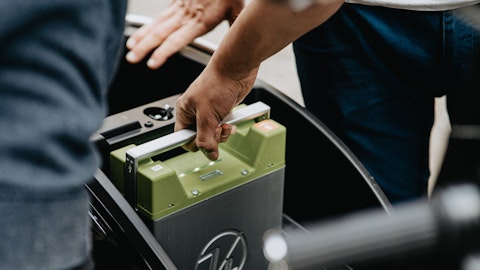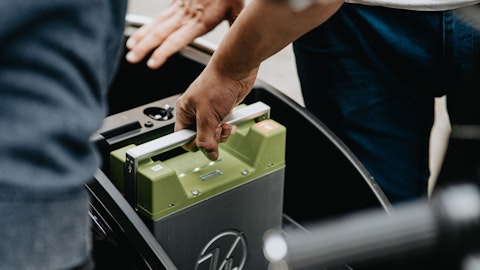As I kind of talked about on the prepared remarks, we expect SG&A to be roughly flat. That’s really project momentum offsetting some of the inflationary costs that we’re seeing as well as digital transformation investment. A&P, we want to increase that, our A&P dollars and probably see us kind of more in that 5% range for the year. Interest, based on our debt pay down and being 90% fixed rate debt, we expect to get about $8 million to $10 million better on interest expense next year and then the tax rate is going to go up a bit. That’s going to be between 22% and 23% next year, so that should be a little bit of a drag on our EPS all in EBITDA kind of in that $600 million to $620 million and EPS of $3.00 to $3.10 – I’d say $3.10 to $3.30. And then for the Q1 outlook, we expect our first quarter to start the year down top line about 6% to 8% and that’s really half of that decline is related to the shift in holiday volume in the just completed fourth quarter.
As we mentioned previously, we’re still seeing weaker performance in some non-track channels and then we’ve also seen a slight shift to channels favoring some value offerings, which has a bit of a share impact on us as well as trade down impact. We expect gross margin to be a little bit better this year than last year in the first quarter and all in, we’re going to see EPS kind of in that $0.50 to $0.60 range.
Jon Poldan: Threw a lot of ads to their bill. Any areas we didn’t answer?
Bill Chappell: No, I think I’ve finished my model for the next year. Perfect. Just one quick follow up. You did allude to the weakness in the non-track channel, and I guess it’s the DIY channel. Is that tougher comps year-over-year or is there something else going on? Or is that just the way those retailers are kind of kind of acting right now in terms of store traffic?
Mark LaVigne: I think it’s a general store traffic trend in non-track channels, depending upon the information that you may get. So that’s DIY and online you are seeing growth. So I would think about this way, brick and mortar, traditional brick and mortar down a little bit on volume, online is up. Non-track, including home center is down.
Bill Chappell: Thanks so much.
Operator: The next question is from Lauren Lieberman with Barclays. Please go ahead.
Lauren Lieberman: Great. Thanks. Good morning. I guess one question I have is this, you think about and talk about some of the trade down and the value seeking behavior you’re seeing from consumers. Now that you’ve got this broader portfolio than you did losing track of time five years ago or so. How does that play in? What can you do with Rayovac? What can you do in terms of your merchandising sets? Is the situation fluid enough that you can leverage that broader portfolio a bit more to position yourself well for changing consumer behaviour? That would be kind of number one. And then just number two is on pricing. Pricing is moving negative with volumes up in track channels and then it looked like the same dynamic in the slide. So just curious what you can tell us a little bit more maybe on the promotional conversation where we stand versus maybe 2019 in terms of normalized promotional levels and where you expect that to settle out? Thanks.
Mark LaVigne: Thanks, Lauren. On the last point, and Bill asked that as well, I think on the promotional levels, we would not see a situation where we would exceed promotional levels from 2019. On your question on value brands, the short answer is yes. We have the full portfolio. We have several value brands that can fill a need, particularly in times that consumers are experiencing now. A little bit easier to do that online because it’s a little bit easier to cut in than it is in a brick and mortar environment, but it is something we’re leveraging. We’re having some encouraging discussions with retailers on that front and that’s one that we’ll continue to leverage as long as the macro environment is what it is today. Anything I missed on that one, Lauren?
Lauren Lieberman: No, I think that’s great. And then can I just switch for a second to Auto, just thinking about long-term margin goals for that business, kind of maybe what you are willing to share on where gross margins in that business are now, kind of where you think you can go to?
Mark LaVigne: I think on that one, Lauren, let me take a step back on what we’ve experienced the last couple of years as an organization. The first thing you dealt with was a pandemic that tested your ability to manage supply chain disruptions, which required sort of greater insights, proactive management of bottlenecks, and just greater resiliency. We not only at the time made the decision to solve the issues of the day, but we invested to improve sort of that operational excellence on a go-forward basis and really enhance the visibility we had across our supply chain. There’s been tremendous progress there. Then we did on auto care in terms of inflation, we got hit, particularly in auto care, with higher inflation, which required pricing.
We’ve launched project momentum to drive sort of cost out of our supply chain. You’ve seen some stabilization on some of the inflation rates, and we’ve really leaned into our pricing and revenue management teams, which as we sit here today, our visibility across our network is dramatically better than it was pre-pandemic. Our fill rates are at or above targeted levels. Our margins are steadily improving. We’ve made tremendous progress in auto care, up nearly 500 basis points as we talked about in the prepared remarks. So beyond the financial results from a supply chain margin management standpoint is the organizational muscle we’ve built to be able to work through these issues in more real-time basis than we have. In terms of Auto Care, we’ve seen great foundational macro trends with the three main factors that drive volume demand in that category and we’ve really retrenched and refocused on margin levels, which we expect to continue to improve this year.


